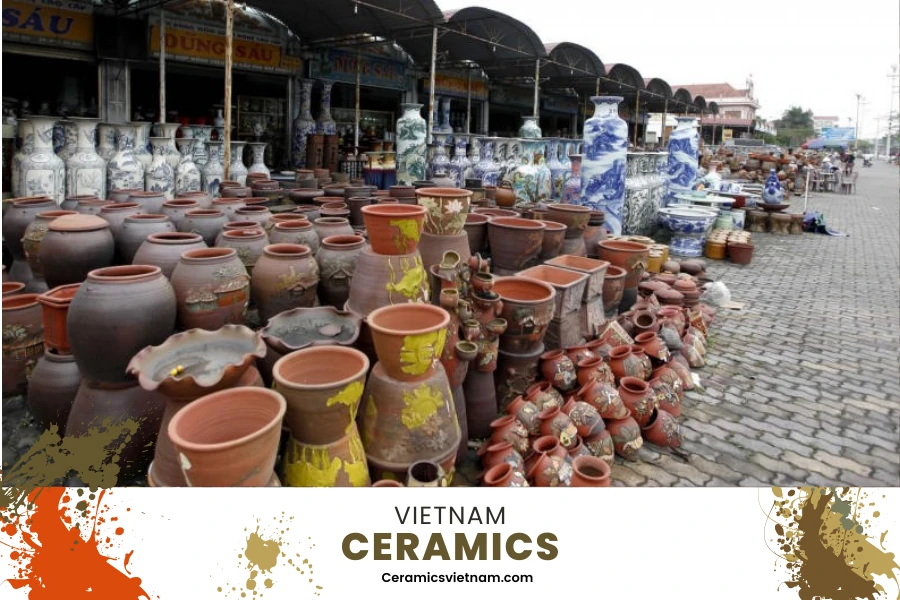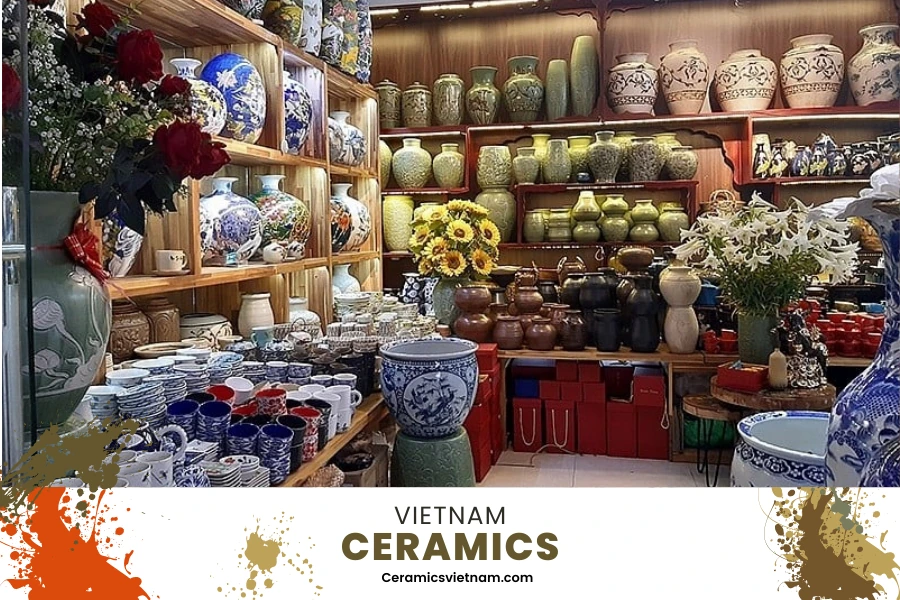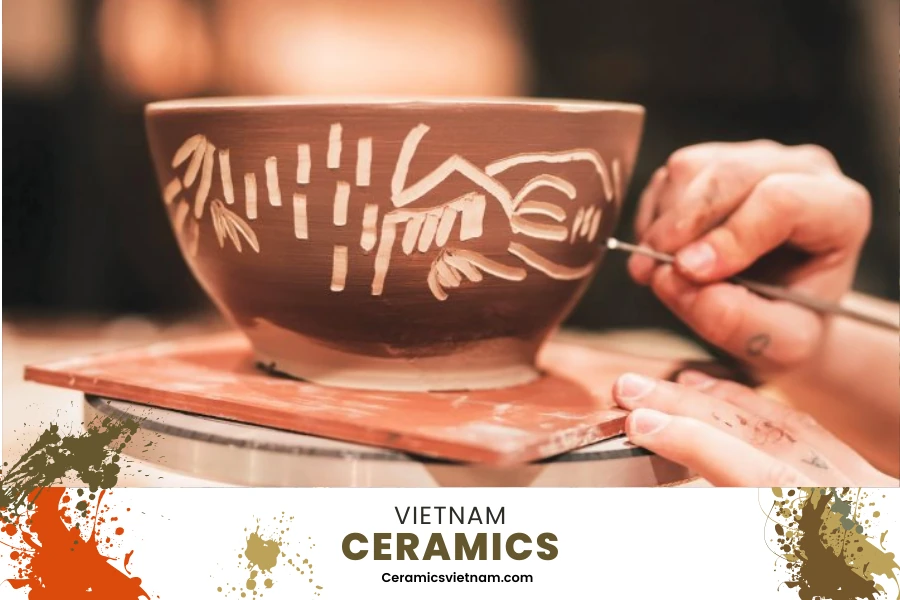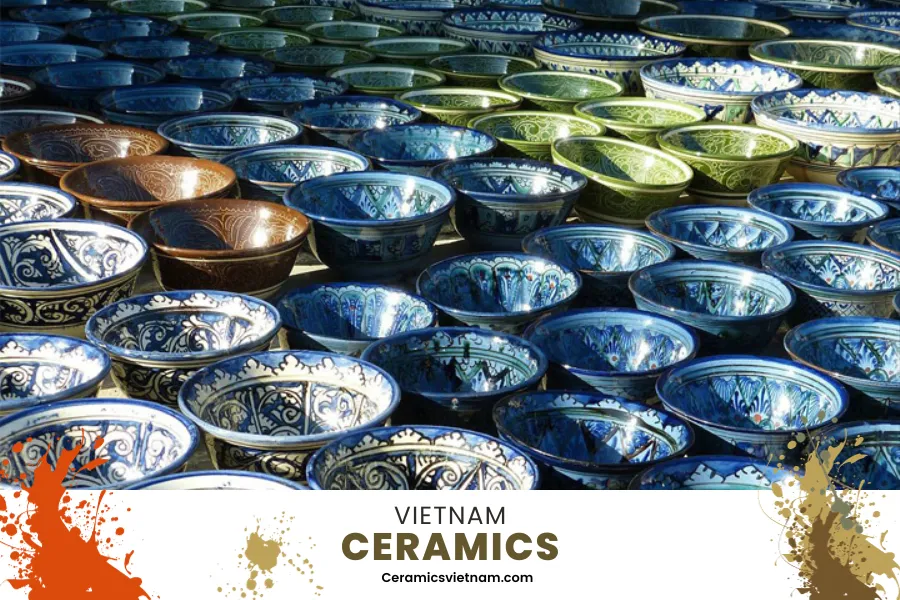Nestled on the banks of the Red River, just a stone’s throw away from Hanoi, lies the quaint and vibrant craft village of Bat Trang Ceramic. Steeped in centuries of tradition and craftsmanship, this village is renowned for its exquisite ceramics, each piece telling a story of skill, heritage, and cultural significance. Join us on a journey as we delve into the rich history, intricate techniques, and timeless beauty of Bat Trang Ceramic, a treasure trove of artistic wonders waiting to be explored.
The Red River, also known as Cai River, Ca River, Thao River, Nhi Ha, Nhi Ha River, is a waterway with a total length of 1,149 kilometers. It originates in Yunnan, China, flowing through northern Vietnam and eventually emptying into the Gulf of Tonkin. Within Vietnam, its length is 556 kilometers. This river holds significant cultural importance for Vietnam’s wet rice civilization
History of Vietnamese ceramics

Exploring the craft village of Bat Trang Ceramic
Ceramics have a rich and ancient history in Vietnam, dating back thousands of years. The art of pottery-making in Vietnam is believed to have originated during the prehistoric period, with evidence of ceramic artifacts dating as far back as the Neolithic age.
Throughout its history, Vietnamese ceramics have been influenced by various cultural and artistic traditions, including those of China, Southeast Asia, and beyond. The country’s abundant natural resources, such as clay and kaolin, have also played a significant role in the development of its ceramic industry.
One of the earliest known centers of ceramic production in Vietnam was the Red River Delta region, where ancient kilns and pottery workshops have been discovered. These early ceramics were often simple in design and utilitarian in nature, serving everyday purposes such as storage, cooking, and ritual use.
During the feudal period, particularly under the Ly and Tran dynasties (11th to 14th centuries), Vietnamese ceramics flourished and began to exhibit more sophisticated craftsmanship and artistic expression. Glazed ceramics, such as celadon and blue-and-white wares, became increasingly popular, reflecting the influence of Chinese ceramic techniques and aesthetics.
In the subsequent centuries, Vietnamese ceramics continued to evolve, incorporating diverse styles, techniques, and decorative motifs. The Le and Nguyen dynasties (15th to 19th centuries) witnessed the production of exquisite ceramics for imperial and aristocratic patrons, including intricately decorated vases, bowls, and figurines.
However, the 20th century brought significant challenges to the Vietnamese ceramic industry, including foreign competition, economic upheaval, and political instability. Traditional ceramic production declined, and many ancient kilns were abandoned or lost.
In recent decades, there has been a resurgence of interest in Vietnamese ceramics, fueled by efforts to preserve traditional craftsmanship and promote contemporary ceramic art. Artisans and ceramicists across Vietnam are revitalizing ancient techniques, experimenting with new forms and materials, and creating innovative works that blend tradition with modernity.
Today, Vietnamese ceramics are celebrated for their beauty, craftsmanship, and cultural significance. They continue to be valued both domestically and internationally, serving as a testament to Vietnam’s rich ceramic heritage and enduring artistic legacy
Introduction to the Bat Trang Village

Exploring the craft village of Bat Trang Ceramic
Introducing the renowned Bat Trang Ceramic craft village, one of the highlights of Hanoi’s tourism landscape. Amidst the tapestry of traditional craft villages that dot the outskirts of Hanoi, such as the silk village of Van Phuc, the conical hat-making village of Chuong My, the flower village of Tay Tuu, the water puppet village of Dao Thuc, the bronze-casting village of Ngu Xa, and the fan-making village of Chang Son, Bat Trang Ceramic holds a prominent position.
What makes Bat Trang Ceramic village so appealing to visitors from all corners? Let CeramicsVietNam introduce you to Bat Trang, a village steeped in our nation’s rich history.
Situated on the banks of the Red River, within the Bat Trang commune, Gia Lam District, Bat Trang Ceramic village lies just over 10 kilometers southeast of the city center. Renowned since the time of the Ly Dynasty, this village boasts over 500 years of history, weathering the ebbs and flows of our nation’s journey. Yet, the name Bat Trang perseveres to this day, growing even stronger.
Bat Trang ceramics are highly esteemed for their quality, offering a wide range of styles and designs, including household ceramics, worship items, artistic ceramics, construction ceramics, and decorative pieces. These ceramics have traversed the length and breadth of our country and even ventured beyond our borders. Bat Trang village is not only a national brand but also a guardian of the capital’s cultural values, earning its status as a favored tourist destination in Hanoi.
Visitors to Bat Trang Ceramic village often find themselves captivated by its timeless charm and genuine atmosphere. The ancient land beckons with its classic ambiance and the warmth of its people, where one can discover intricately crafted vases and pots adorning every corner.
The highlight of a tour to Bat Trang is undoubtedly the opportunity to try one’s hand at pottery-making. At the ceramic workshops in the village, visitors are guided through the pottery-making process, marveling at the skill and precision of the village artisans. Here, amidst the ancient clay, visitors can shape their own cups and bowls, guided by the expert hands of the craftsmen.
To experience this activity, tourists can head to the Pottery Market, where many families offer pottery-making services for visitors. The cost for a pottery-making session ranges from 40,000 to 60,000 Vietnamese dong. Visitors need not worry about ruining their first attempts; the artisans are patient guides, ensuring that each creation is a masterpiece.
The clay creations made by visitors are left to dry for 30 minutes before being decorated and fired like other Bat Trang products. Visitors can take home their creations as cherished souvenirs of their experience.
Two must-visit destinations in Bat Trang are the Vạn Vân House and the Village Ceramic Shrine, where visitors can marvel at over 400 rare ceramic artifacts dating back to the 15th and 19th centuries.
At the Village Ceramic Shrine, located beside the Red River, visitors can delve deeper into the traditions of Bat Trang village. Here, one can savor the finest culinary delights the village has to offer, with numerous street food stalls serving delectable dishes at affordable prices. Among the culinary delights, the most famous is the bamboo shoot and squid soup, renowned for its traditional flavors.
Bat Trang Ceramic – Meaningful and Practical Artifacts When visiting Hanoi, tourists not only explore the sights but also seek out souvenirs to commemorate their journey. Bat Trang is the ideal destination for purchasing meaningful gifts for friends and family. The Pottery Market is the go-to place, housing numerous longstanding ceramic shops. Each shop displays a plethora of beautiful products, from vases, bowls, teapots to wall hangings, necklaces, and bracelets.
Ceramic making process

Exploring the craft village of Bat Trang Ceramic
- Preparing the Clay: The process begins with preparing the clay, which involves selecting the right type of clay and mixing it with water to achieve the desired consistency. The clay is then kneaded to remove air bubbles and ensure uniformity.
- Shaping: Once the clay is prepared, it is ready for shaping. There are various techniques for shaping clay, including hand-building methods like pinching, coiling, and slab construction, as well as wheel-throwing techniques on a pottery wheel.
- Decorating: After shaping, the ceramic piece can be decorated using different methods. This may include carving designs into the surface, applying glazes or underglazes for color, or adding texture using tools or stamps.
- Drying: Once decorated, the ceramic piece needs to dry thoroughly before firing. This drying process can take several days or even weeks, depending on the size and thickness of the piece.
- Bisque Firing: After drying, the ceramic piece undergoes the first firing, known as the bisque firing. This firing process removes any remaining moisture from the clay and prepares it for glazing.
- Glazing: Once bisque-fired, the ceramic piece is ready for glazing. Glazes are applied to the surface of the piece to add color and create a protective layer. Glazed pieces are then fired again at a higher temperature to melt the glaze and fuse it to the clay.
- Final Firing: After glazing, the ceramic piece undergoes its final firing. This firing process vitrifies the clay and glaze, making the piece durable and waterproof. The temperature and duration of the final firing depend on the type of clay and glaze used.
- Cooling and Finishing: Once the final firing is complete, the ceramic pieces are allowed to cool slowly in the kiln before being removed. After cooling, any rough edges or imperfections are smoothed out, and the pieces are ready for display or use.













Leave a reply